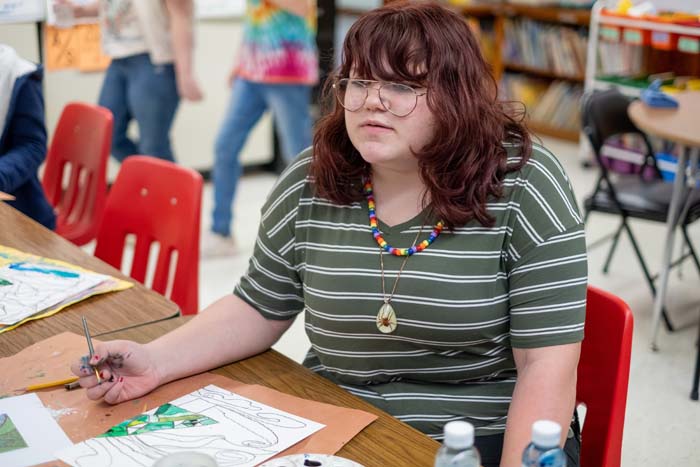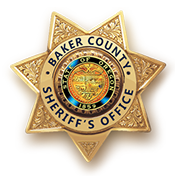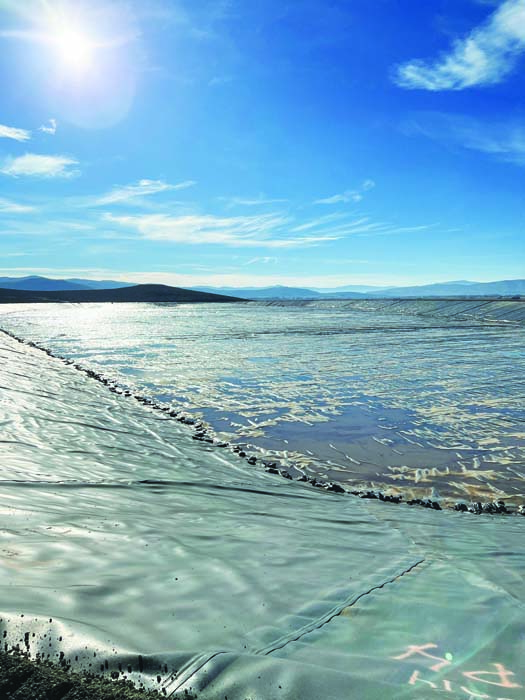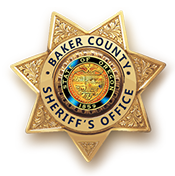Opportunities for online education are spreading across Eastern Oregon
Published 6:00 am Friday, February 9, 2024

- Emma Walker, 13, seventh-grade at Pendleton Virtual Learning Academy, reflects Nov. 29, 2023, on her home schooling experience in comparison to a classroom at the Pendleton School District.
PENDLETON — A group of young students sat at tables arranged in a U shape, facing their teacher, who was demonstrating how to create the appearance of stained glass windows on paper using crayons and paint.
It was 1 p.m. on a Wednesday during November 2023 in Pendleton, but the students weren’t in school. Or, at least, not in any kind of traditional classroom. Seeing them sitting at low tables, laughing and chatting as they worked on their art, it might be hard to believe that the group consisted of students ages 7 to 13 attending school online.
Virtual learning — taking classes online, with little to no in-person components — in the United States has been around for more than a decade. Although it’s more common at the college level or for students who require a flexible schedule, the coronavirus pandemic led to innovations around distance learning for all ages.
This sudden shift in how mainstream primary schools deliver their education introduced the idea to the general public that online learning could work for more than college students or to fit niche needs for aspiring athletes or performers.
In Eastern Oregon, for example, opportunities for online education are spreading. InterMountain Education Service District offers online schooling — virtual learning academies — in partnership with various districts it serves, and online charter schools offer virtual education to students across the state.
For students in the art club, it’s a weekly opportunity to connect with one another off-screen.
“They’re still getting that social aspect,” said Scarlette Sprague, who has two students enrolled in the Pendleton Virtual Learning Academy.
Sticking to the district
InterMountain Education Service District’s virtual learning academies are considered part of the districts themselves. The academies started in 2020, when there was an exodus of students from public schools, said Lena Wheeling, principal of the education service district’s virtual learning academies.
“There was a need to provide schooling for students who didn’t want to return to in-person learning,” she said. “We consider last year really our first year of providing continued effort of providing that stability in virtual learning.”
In the 2021-22 school year, Wheeling said, more than 900 students were enrolled at some point throughout the year. In 2022-23, the first “normal” year, total enrollment was 832.
Students in K-5 must be enrolled full time, while older students sometimes have the chance to attend in a hybrid format, taking classes at their district school as well as online.
Student success is the education service district’s priority, Wheeling said, and providing them opportunities they may not have had otherwise is a key part of that. Students can take classes in environmental science or business and marketing, and there’s a computer science pathway in the works.
“We provide course opportunities for the really small schools where the school can’t provide a teacher for the course of interest,” she said. “We really meet a variety of needs for students, for their families and for the community.”
Wheeling said that other online programs are full-on schools in and of themselves, while the virtual learning academies are what’s called a program of service, working directly with different districts that opt into purchasing the contracted virtual learning service for specific students using state funding.
Each district has a liaison to help students and families, oversee communication and organize activities or opportunities for students.
The online students still are members of their home district. They can participate in district extracurricular activities, such as sports teams or clubs, and their grades and diplomas are determined by district standards. The accreditation still comes from the district, and their diploma will show the name of whichever district they belong to.
But even in the virtual classrooms, teachers are local.
“When they go to email their teacher, they’re not going to get someone from New York. They’re going to get someone from Echo, or Heppner or La Grande,” Wheeling said. “It speaks to the culture and way of life in our region, and those teachers are a part of that.”
Wheeling said she hopes students and their families can feel the difference.
A statewide approach
As with online schooling more broadly, virtual public charter schools are expanding as options for students across Oregon.
Two prominent options in Eastern Oregon are Oregon Connections Academy and Baker Charter Schools.
Baker Charter Schools offers Baker Web Academy as well as Baker Early College. The charter is sponsored by Baker School District and is an Oregon-based online program founded in 2008.
Connections Academy is part of a nationwide network of online schools under Pearson, a national company known for making textbooks and curriculum. The charter school is authorized by the Prairie City School District, which reports enrollment to the state to receive Oregon Connection Academy’s funding.
Unlike the virtual learning academies with InterMountain Education Service District, which are associated with specific districts because each academy is part of its district, Oregon Connections Academy and Baker Charter Schools are not counted as equivalent to the district.
The Oregon Department of Education said that funding follows the students. As online charter schools, they receive funding from the state for each student via their sponsor district but remaining separate entities from that sponsor. The district does get to keep a certain percentage of the funding as part of taking on the role of sponsor, but most of it goes to the charter.
For the Baker School District, Baker Charter Schools students account for more than half the district’s overall enrollment. The charter schools had a daily average attendance in 2022-23 of 2,693, out of the district total of 5,157. The district received almost $45 million from the Oregon State School Fund for that fiscal year, of which 56.5% was transferred to Baker Charter Schools, according to the district’s financial audit.
When students graduate from the online charters, as opposed to the education service district academies, their diplomas name that charter, since each is its own standalone school.
Janel Scurlock is the principal of Oregon Connections Academy, which opened at the start of 2021 after its sister school, Willamette Connections Academy, reached full enrollment capacity.
“They just got so big, so fast. We needed help for the overflow,” she said.
At first, around 100 students attended the online charter school, but now, Scurlock said, more than 1,000 students attend from all over the state. She attributes that boost, at least in part, to the pandemic, a time period in which people may have realized it was an option.
Scurlock does recognize the stereotypes of online schools, but said she doesn’t think Oregon Connections Academy is less rigorous than traditional schools.
“I think we just have a lot more flexibility than brick and mortar,” she said. “We can be a lot more flexible in our environment because the kids work asynchronously on the curriculum, and they come to us for live lessons.”
After COVID-19, she said, people are realizing there are multiple ways to learn and all kinds of ways to engage with children so they are successful in school. Online charter schools provide one way of doing that.
The pandemic effect
Data from the Oregon Department of Education shows that immediately after schools reopened in person from COVID-19, many students continued with online schooling, with 4.5% of students remaining online in the 2021-22 school year.
However, from a statewide perspective, the 2022-23 school year’s enrollment of 2.8% online is similar to the numbers in years preceding the pandemic, such as the 2.5% of students enrolled virtually in 2018-19.
In pure numbers, that means a little more than 1,000 additional students were enrolled in online programs last year compared to the 2018-19 school year.
Not every school in the state saw the exact same trends, though.
Baker Charter Schools Superintendent Roland Hobson said their schools saw a marked difference in enrollment after the pandemic showed everyone that online schooling really isn’t that scary. Since everyone had to try it, people understand what virtual learning actually means now.
“It’s changed the dynamic for us as an entity because it’s not seen as scary or unknown anymore,” he said.
So, although the virtual program was established about 15 years ago, it continues to see growth. Students attend from all across the state, with teachers based around Oregon, too.
The K-12 program within Baker Charter Schools, Baker Web Academy, has 2,750 students, an increase of around 400 students from the 2022-23 school year, and far more than many of the brick and mortar schools in the region. Around 350 of the Web Academy students live in Eastern Oregon.
As online programs continue to grow in popularity, they also must evolve. Hobson said Baker Charter Schools worked with the Oregon Department of Education to identify specific pillars of online learning.
Generally, Hobson said, having a blend of synchronous and asynchronous learning opportunities is beneficial for students. Another area that Baker Charter Schools is specifically working to improve now is getting students working with other students.
Working in a team, learning to navigate group relationships, is an important skill for students regardless of what they plan to pursue as adults.
“That’s one of those soft skills that all employers and colleges are looking for,” Hobson said. “I think that would be a huge piece for online learning, especially for us as an asynchronous school. Putting students with students, having educational kinds of conversations, having dialogue around topics or whatever curriculum they’re working with. That would be my biggest improvement, actually.”
Here to stay
Building real-life skills and connections is a central goal for each of the online programs.
“My kids went from barely surviving to thriving,” said Sprague, the mom with two young children attending the Pendleton Virtual Learning Academy.
Her eldest, Harmoney, said, “I was having a difficult time in real-people school.”
Harmoney, 11, was struggling to complete assignments, and her mom felt like the school wasn’t listening.
“If you’re barely keeping your head above water, eventually you’re going to drop,” Sprague said. “I signed her up for this program and she flew. Fast.”
Harmoney talked as she worked on her craft version of stained glass. She sat next to her friend, Paradise, and smiled a lot as she talked about her teacher and what school is like for her now.
“I get a lot of help that I feel like I need,” Harmoney said of her school and classes now. “My grades are better.”
Her mom agreed.
“Even though there’s a computer aspect where you think it’d be impersonal, they actually care about my kids and their education just as much as I do,” she said.
She tells everyone she knows they should enroll their students in the virtual learning academy, Sprague said. Both children are still getting the social interactions they need, but they’re also in an environment that’s working better for them.
“These teachers, they’re caring and they’re loving and they don’t get the recognition that they honestly deserve,” she said. “They are just heartfelt people and it’s amazing what they’ve done to help my little family.”
It took switching over for her to realize what her kids had been missing.
“It’s like constantly having hot dogs and then you’re given a steak,” she said.
Virtual learning, real relationships
Opportunities to collaborate may be an area of improvement, but online schools are becoming more intentional with offering ways for students to build social and emotional relationships.
Teachers at Baker Charter School each work with two main focuses — as a grading teacher and as an advisory teacher.
The grading side of their work is the more traditional work of a teacher — by supporting student learning within a specific subject, such as science or math. Stepping into their advisory roles, they are assigned 30 students who they check in with to see how they’re doing from a broad perspective throughout whatever length of time they’re at Baker Charter Schools.
Staying with a student for years as their advisory teacher allows the teachers to build deeper, individual relationships, which helps with student success.
Pendleton Virtual Learning Academy, with all its students living in the Pendleton School District, does not face the same challenges with getting students together, so students there have even more opportunities to interact with one another.
Jenny Corey, the K-8 coordinator, oversees a regular study hall for middle school students and leads the weekly art club for the K-8 students, sometimes even offering field trips to local attractions or events.
“What has set us apart and how we’ve retained our enrollment is that I offer some in-person space for them,” she said. “I have a study hall every day for my middle school kids. They can work every day and have a quiet place to work and I’m there every day.”





